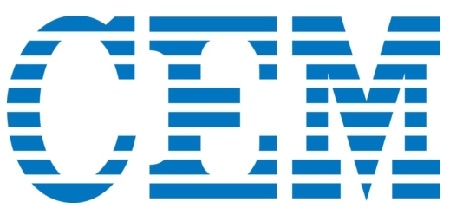The majority of home cleaning products are produced using a combination of expensive active ingredients suspended in a low-cost filler, like water.
Optimization of the material costs per batch of cleaning product produced is possible by determining the total solid content in the solution. This analysis should be carried out quickly during production to ensure fast batch release and, in the event of poor results, to minimize downtime.
As cleaning products contain a wide range of different volatile compounds solid test methods have conventionally been carried out using a vacuum or air oven. Whilst this method is useful as it can dry all different kinds of samples, it is also slow and can take hours to carry out.
The time taken to carry out solids analysis can be significantly reduced using infrared-only analyzers, which require no more than 25 minutes to dry the active ingredients in cleaning products. However, 25 minutes is still a long wait, and because of poor ventilation many of the liquid softeners and detergents can re-condense inside the system.
Microwave-only analyzers are faster than infrared-only analyzers, being able to carry out the total solids analysis in minutes. However, if glycerine is present in the sample, as it often is, the sample can be sourced. In addition, if the product does not use an aqueous solvent it will not be excited by the microwave radiation, making the system ineffective.
To counter the problems associated with drying indirect analysis methods, (e.g. infrared analysis) have been used to carry out total solids analysis. Whilst these methods are accurate, they are expensive to calibrate and are also very sensitive to changes in product formulation and color.
The SMART 6™ is an analysis system which was produced for the total solids analysis of household cleaning products, regardless of if they are a high-solids paste, contain many different volatile ingredients, or if they are suspended in an aqueous or non-aqueous solvent.
The SMART 6™ dries samples using a dual-frequency (IR and microwave) method for fast solid analysis. The IR radiation produces molecular vibrations, which uniformly heat the sample, whereas the microwaves pass through the sample and rapidly remove moisture/water.
The two technologies complement each other, providing advantages that IR-only and microwave-only systems cannot, to achieve an analysis time of just 4 minutes.
The study explored below shows that the SMART 6™ is capable of the fast-total solids analysis of different cleaning products, with an average difference of less than 0.08% when compared to conventional methods.
Experimental
To test the performance of the SMART 6™ total solids analyzer different commercially available household goods were tested – dish paste, dish detergent, laundry detergent and fabric softener.
For total solids analysis a 1 – 2 g sample of each were run through the SMART 6™, which provided constant, uniform drying with IR and microwave radiation. Reference tests were carried out three times using an air oven at 100 °C over 4 hours.
Results
When compared to oven methods the SMART 6™ results (given in terms of total solids percentage) showed only 0.04% - 0.08% difference to oven drying, showing just how accurate the system is (Table 1).
Table 1: Accuracy of SMART 6 Technology Compared to Reference Methods
| Sample |
Percent Solids |
| SMART 6 |
Oven |
Difference |
| Dish Detergent |
28.53 |
28.57 |
0.04 |
| Dish Paste |
78.50 |
78.42 |
-0.08 |
| Laundry Detergent |
10.50 |
10.55 |
0.05 |
| Fabric Softener |
3.28 |
3.33 |
0.05 |
Table 2: Precision of SMART 6 Technology
| Sample |
Percent Solids Replicates |
Average |
Range |
Std. Dev. |
| 1 |
2 |
3 |
4 |
5 |
6 |
7 |
8 |
9 |
10 |
| Dish Detergent |
28.46 |
28.48 |
28.61 |
28.55 |
28.60 |
28.50 |
28.47 |
28.50 |
28.70 |
28.45 |
28.53 |
0.22 |
0.08 |
| Dish Paste |
78.42 |
78.56 |
78.57 |
78.54 |
78.40 |
78.50 |
78.34 |
78.60 |
78.60 |
78.54 |
78.50 |
0.25 |
0.08 |
| Laundry Detergent |
10.61 |
10.33 |
10.50 |
10.65 |
10.50 |
10.50 |
10.52 |
10.50 |
10.20 |
10.55 |
10.50 |
0.37 |
0.12 |
| Fabric Softener |
3.20 |
3.24 |
3.27 |
3.27 |
3.26 |
3.32 |
3.33 |
3.33 |
3.35 |
3.25 |
3.28 |
0.15 |
0.05 |
Table 2 demonstrates the precise nature of dual frequency drying, which had less than 0.12% standard deviation for all of the analyzed samples.
Conclusion
Using the dual-frequency (IR and microwave) technology in the SMART 6™ total solids analyzer allowed a variety of samples with different volatilities and consistencies to be thoroughly dried in less than 4 minutes, with no scorching.
Comparing the results with a reference showed that the method is highly accurate, with a deviation of less than 0.08% from the accepted conventional method.
The combination of IR and microwave energy provides benefits that neither technology can provide alone, facilitating the drying of all kinds of samples at high accuracy and precision.
Key System Benefits
- Versatility – Any type of dry or wet product can be analyzed, e.g. gels, pastes, powders and in-process mixes
- Simple – Controlled via a touchscreen interface, allowing unskilled operators to use the system
- No Calibration – Analysis can be carried out directly with no need to waste time and money carrying out calibrations
- Reliable – The results can be trusted, with no need to be concerned about variations in sample density, color, consistency or formulation

This information has been sourced, reviewed and adapted from materials provided by CEM - Process Control.
For more information on this source, please visit CEM - Process Control.